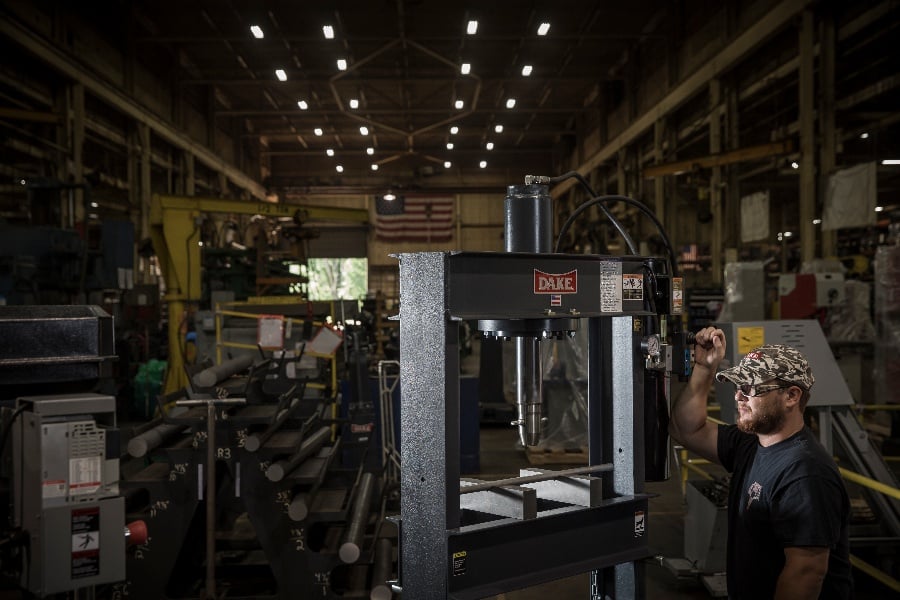Basic mechanical presses can accomplish simple tasks on a shop or factory floor. However, when you have more complicated jobs, you need a more sophisticated press. Two common machines to use in these circumstances are hydraulic presses and Servo presses.
These two types of machines have different strengths and weaknesses. This article will explore the fundamentals of the presses and help you determine which best meets your specific needs.
What are Hydraulic Presses?
Hydraulic presses are closed systems that use liquid moving under pressure. Invented in 1795 by the flush toilet’s originator Joseph Bramah, they depend on a theory in fluid mechanics developed by Blaise Pascal in the seventeenth century. Pascal’s law asserts that when pressure changes anywhere in a closed system, it changes everywhere within that system.
The presses themselves put pressure on an element, forcing the press to function. A piston presses into an oil-filled chamber which causes the oil to move. This puts pressure on a baseplate or another piston, pressing the tool into a downward motion.
Hydraulic presses are both dependable and strong. Jobs using tougher materials and those involving a large amount of products to be pressed can best use this machine tool.
Hydraulic presses are slower than similarly sized traditional mechanical presses. This can be an advantage in certain circumstances such as moulding, punching, blanking, forging, deep drawing, clinching, and metal forming.
They can also require a good deal of maintenance leading to downtime. They also require the use of other devices to monitor oil pressure and efficiency.
There are three common types of hydraulic presses. C press frames are often used in the auto industry. They are shaped like the letter “C” and can form mild or moderate applications. H Frame Presses, often used in the appliance industry, is top-driven and can apply pressure to a wide variety of materials. These are the most commonly used Hydraulic press in industry. Finally, the heavy duty Channel Presses use a lot of ram force. They are often used in the aviation industry to stress test.
Hydraulic presses give you a significant bang for your buck with a relatively low initial cost.
To see a hydraulic press in action, you can watch The Hydraulic Press Channel on Youtube where Finnish factory owner Lauri Vuohensilta uses one to crush a variety of objects including golf balls, Barbie dolls, diamonds, and even explosive materials.
What are Servo Presses?
Servo Presses on the other hand use servomotors to drive the machine. They have variable slide motion allowing you to control both the position and speed of their output shafts creating a closed-loop feedback system to accurately produce control cycle rates and loads.
Servo Presses are a recent innovation. They were introduced at EuroBLECH 2004. Industries using large presses immediately saw the advantages presented by the new technology. However, they are among the most expensive mechanical presses available.
Historically, in order to increase the tonnage between a die and its work piece, you had to use big presses with big motors. The Servo Press is smaller and uses only 10 to 20 percent of the energy required for other press machines.
Where most presses cycle at constant speeds, Servo Presses use computer software to more flexibly control press speeds and positions. This allows shops to apply high forming loads early in the stamping process. Automakers, for instance, find the Servo Press allows them to use more complex part geometries and still maintain dimensional precision.
Servo Presses have many advantages including an adjustable stroke, speed, energy savings, quality, a longer tool life, and less downtime than tools that perform similar functions.
Servo Presses can use either link-assisted or direct drive systems. Link assisted systems use standard off-the-shelf motors whereas direct drive systems require proprietary high tech low rpm motors.
The presses allow you to get a perfect 90 degree cut surface, scrap less material, and run faster than fineblanking.
While they are still a small portion of the stamping industry, many companies purchasing new presses are deciding to go with the Servo Press. Industry is increasingly relying on high strength-to-weight ratios and recognizing the value of this new tool.
Which Press is Best?
The press you choose depends on what you need it to do.
When you need to draw and press complex parts, Hydraulic Presses are your best option. If you need to produce deep, complex forms requiring significant material flow and do not need high production speed, a hydraulic press could work for you.
Shops producing tanks, cylinders, and bowl shapes often use hydraulic presses. If you require a dwell at the bottom of the stroke, this is the machine for you. The hydraulic press is often used in pulp and paper manufacturing, wood products, wind turbine manufacturing, and marine and offshore systems.
Servo presses are best used when you need the full press capacity of a traditional mechanical press, but at a faster speed and smaller footprint. You can fully work the energy at any speed and dwell anywhere in the stroke.
The Dake Corp. has a full range of quality, reliable machine tools including a full line of hydraulic presses.

